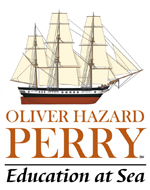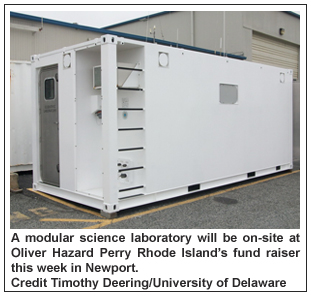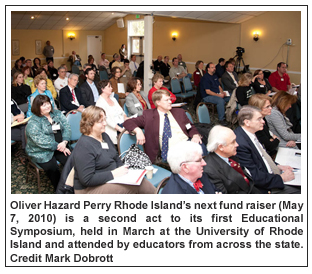
Rhode Island’s Education at Sea Tall Ship Oliver Hazard Perry:
First Educational Symposium a Success; Fund Raiser Rings Bell for Experiential Learning
 NEWPORT, R.I. (May 2, 2010) – For some non-profit organizations, it might seem precarious to have one foot on the dock and the other on a boat, but for Oliver Hazard Perry Rhode Island (OHPRI) it is just this situation that is helping to turn the concept of Rhode Island’s Education at Sea Tall Ship into a reality. As it stands, OHPRI already owns the steel hull of what, in 2012, will be christened the SSV Oliver Hazard Perry. After the deck, masts, rigging, sails and electronics have been added and its at-sea education programs for secondary schools and colleges established, the Oliver Hazard Perry will sail as a 207-foot three-masted, square rigger--the largest privately owned school ship in America. This is the platform on which OHPRI has established its fund raising and educational goals, and it has held steady in the water as more and more supporters come to realize there is little, if any, proverbial gap between the dock and this magnificent opportunity.
NEWPORT, R.I. (May 2, 2010) – For some non-profit organizations, it might seem precarious to have one foot on the dock and the other on a boat, but for Oliver Hazard Perry Rhode Island (OHPRI) it is just this situation that is helping to turn the concept of Rhode Island’s Education at Sea Tall Ship into a reality. As it stands, OHPRI already owns the steel hull of what, in 2012, will be christened the SSV Oliver Hazard Perry. After the deck, masts, rigging, sails and electronics have been added and its at-sea education programs for secondary schools and colleges established, the Oliver Hazard Perry will sail as a 207-foot three-masted, square rigger--the largest privately owned school ship in America. This is the platform on which OHPRI has established its fund raising and educational goals, and it has held steady in the water as more and more supporters come to realize there is little, if any, proverbial gap between the dock and this magnificent opportunity.
“We have interest in marine and environmental studies and programs across the curriculum,” said Winnie Brownell, Dean of the College of Arts and Sciences at the University of Rhode Island (URI), where OHPRI held its first Educational Symposium in March. “One thing we know about learners today is that they respond positively to experiential learning. The old days of the ‘sage on the stage’ are pretty much over.”
Educators from across the state agreed about the endless possibilities of the Oliver Hazard Perry as an at-sea experiential learning platform. URI’s Professor of History and Archeology Rod Mather presented his dream scenario of a 6-9 credit course aboard the Oliver Hazard Perry in Bermuda, where he runs an underwater archeology field school. “We are limited in what we can do there by very small boats that can go only a certain distance offshore. With the Oliver Hazard Perry, we would be able to expand our research programs and combine them with such interdisciplinary subjects as humanities, social sciences, maritime history, literature of the sea, anthropology, natural resource economics, oceanography, engineering, even applied mathematics—there are no real limits on the kinds of things we could do.”
 To address how the ship would successfully adapt to the needs of different groups with different curriculums, Bay Marine’s Dave Bonney, who is serving as OHPRI’s chief naval architect, presented Oliver Hazard Perry’s renderings and plans for development. He explained that deck plans include spaces for portable Lab Vans, which are modular science laboratories managed and distributed on behalf of the National Science Foundation by the University of Delaware (for the East Coast Van Pool) and Oregon State University (for the West Coast Van Pool). “There are dry labs, wet labs, isotope labs, cold labs, and clean labs,” said Bonney, also pointing out that some colleges, like URI, own their own lab vans. “They are an easily transported, affordable way to customize a journey for, let’s say, science experimentation on one excursion and scuba diving on the next.” The Oliver Hazard Perry also incorporates traditional classroom space below decks along with berthing, which can accommodate 38 students on overnight sails.
To address how the ship would successfully adapt to the needs of different groups with different curriculums, Bay Marine’s Dave Bonney, who is serving as OHPRI’s chief naval architect, presented Oliver Hazard Perry’s renderings and plans for development. He explained that deck plans include spaces for portable Lab Vans, which are modular science laboratories managed and distributed on behalf of the National Science Foundation by the University of Delaware (for the East Coast Van Pool) and Oregon State University (for the West Coast Van Pool). “There are dry labs, wet labs, isotope labs, cold labs, and clean labs,” said Bonney, also pointing out that some colleges, like URI, own their own lab vans. “They are an easily transported, affordable way to customize a journey for, let’s say, science experimentation on one excursion and scuba diving on the next.” The Oliver Hazard Perry also incorporates traditional classroom space below decks along with berthing, which can accommodate 38 students on overnight sails.
Caroline Goddard, a B.A. graduate in Visual Art from Brown University, shared her experience from a six-week semester at sea with the Massachusetts-based Sea Education Association. “It wasn’t an approach to sailing in the way we might think, as recreation for the affluent, and it certainly wasn’t about sitting in a deck chair eating tropical fruit. Instead it was about the historical process, the traditions and also that sailing was – and still is -- a way of life for many people. We learned about the oceans, how to navigate, and how to run the ship. It challenged me socially, physically and mentally and taught me about what I can do when pushed. It has been a constant source of inspiration in my art work and is making its way into my senior thesis.”
Speaking to the opportunities for secondary and middle school teachers was Jim Young, Head Master of Rocky Hill School in East Greenwich, R.I.: “It’s a very special conversation beginning. It’s like building the Great Wall of China in a day, because the kinds of things we can do and envision doing with the Oliver Hazard Perry are extraordinary.”
Young described a pilot program at Rocky Hill where a catamaran is used on Narragansett Bay and the Sakonnet River to bring math, Latin, photography and physics lessons to life for his students. “You can learn all those things in a classroom, but until you touch them, smell them, feel them, they never come alive. The Oliver Hazard Perry will allow that. It’s learning for life, learning that is not limited to something between the covers of books. And let’s imagine that kids from our different schools across the state -- public, independent private, at-risk, Montessori, parochial -- can sail together. They are not passengers but active crew members, studying a rigorous curriculum and participating in social and collaborative learning, creative problem solving and innovative thinking, living in a small space where they learn to appreciate and respect others around them.”
OHPRI’s Chairman Bart Dunbar explained that the Oliver Hazard Perry has the capacity--with a proposed schedule of day trips (for 85 students) and semester weeks, to log 12,000 student days at sea. “The beauty of partnering with different programs across the state means that the economics are spread out, so no one program has to carry a huge financial burden,” he said. “And we are not limited to working solely with secondary/middle schools and universities. In our backyard is the Naval War College and the Naval Academy Prep School and a multitude of marine trades programs that can coordinate with the actual building of the ship over the next two years and its schedule, once completed, of two four-week periods shore-side each year for maintenance and repair.”
TOP
|